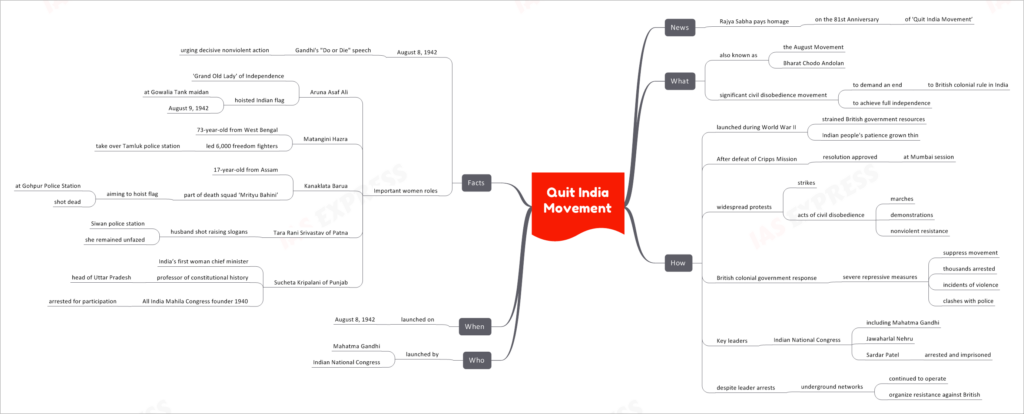Quit India Movement

The recent homage paid by the Rajya Sabha on the 81st Anniversary of the ‘Quit India Movement’ serves as a poignant reminder of the significant civil disobedience movement that played a pivotal role in India’s journey towards freedom from British colonial rule.
The August Movement: Demanding Freedom
The Quit India Movement, also known as the August Movement or Bharat Chodo Andolan, was a historic civil disobedience movement launched during World War II. It aimed to bring an end to British colonial rule in India and achieve full independence through nonviolent resistance.
Seeds of Discontent and Launch
The movement was born out of the strain that World War II placed on British government resources. The Indian people’s patience had grown thin due to the continuing British domination. After the failure of the Cripps Mission, a resolution for the Quit India Movement was approved at the Mumbai session of the Indian National Congress.
Unwavering Resistance
The movement witnessed widespread protests that included strikes, marches, demonstrations, and acts of civil disobedience. These acts of nonviolent resistance were met with severe repression from the British colonial government, resulting in thousands of arrests, incidents of violence, and clashes with the police.
Key Leaders and their Role
Prominent leaders of the Indian National Congress, including Mahatma Gandhi, Jawaharlal Nehru, and Sardar Patel, played crucial roles in leading the movement. Despite their arrests and imprisonment, underground networks continued to operate, organizing and sustaining the resistance against British rule.
The Who, When, and Where
Launch and Leadership
The Quit India Movement was launched by Mahatma Gandhi and was championed by the Indian National Congress. This movement aimed to challenge British colonial rule through nonviolent means.
Historic Date
The movement was launched on August 8, 1942, marked by Mahatma Gandhi’s iconic “Do or Die” speech, which urged the Indian populace to take decisive nonviolent action in the struggle for freedom.
Places of Significance
The movement unfolded across India, with key events taking place in various regions that highlighted the determination and bravery of the participants.
Notable Figures and Heroic Contributions
Aruna Asaf Ali: The Grand Old Lady of Independence
Aruna Asaf Ali, known as the ‘Grand Old Lady’ of the Independence movement, hoisted the Indian flag at the Gowalia Tank maidan on August 9, 1942, symbolizing the resolute spirit of the movement.
Matangini Hazra: A Symbol of Courage
Matangini Hazra, a 73-year-old from West Bengal, led 6,000 freedom fighters in taking over the Tamluk police station, exemplifying the diverse and fearless participation in the movement.
Kanaklata Barua: Sacrifice for the Cause
Kanaklata Barua, a 17-year-old from Assam, was part of the ‘Mrityu Bahini’ or death squad aiming to hoist the flag at the Gohpur Police Station. She was tragically shot dead, representing the immense sacrifices made by the youth.
Tara Rani Srivastav: Unyielding Spirit
Tara Rani Srivastav of Patna stood unfazed even after her husband was shot while raising slogans at the Siwan police station. Her strength and courage became a source of inspiration.
Sucheta Kripalani: Leading the Way
Sucheta Kripalani, India’s first woman chief minister and a professor of constitutional history, played a vital role in the movement. As the head of the Uttar Pradesh All India Mahila Congress, she was arrested for her active participation.
If you like this post, please share your feedback in the comments section below so that we will upload more posts like this.

